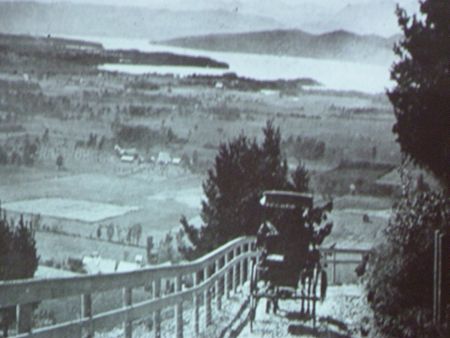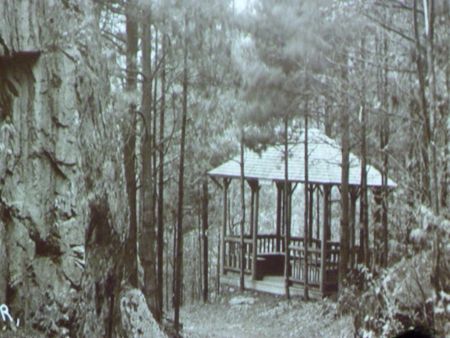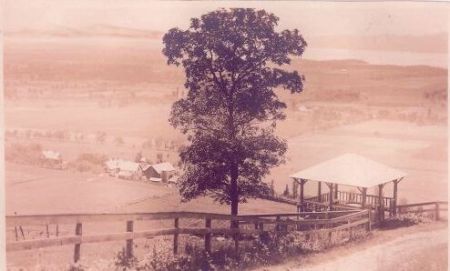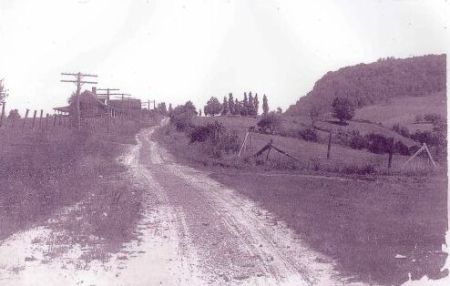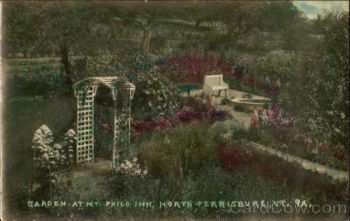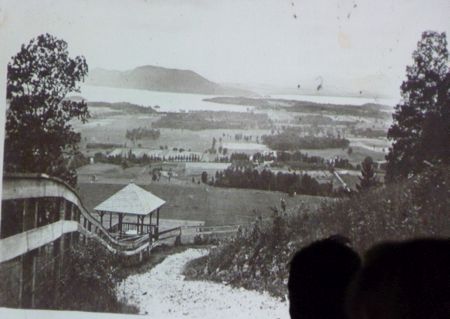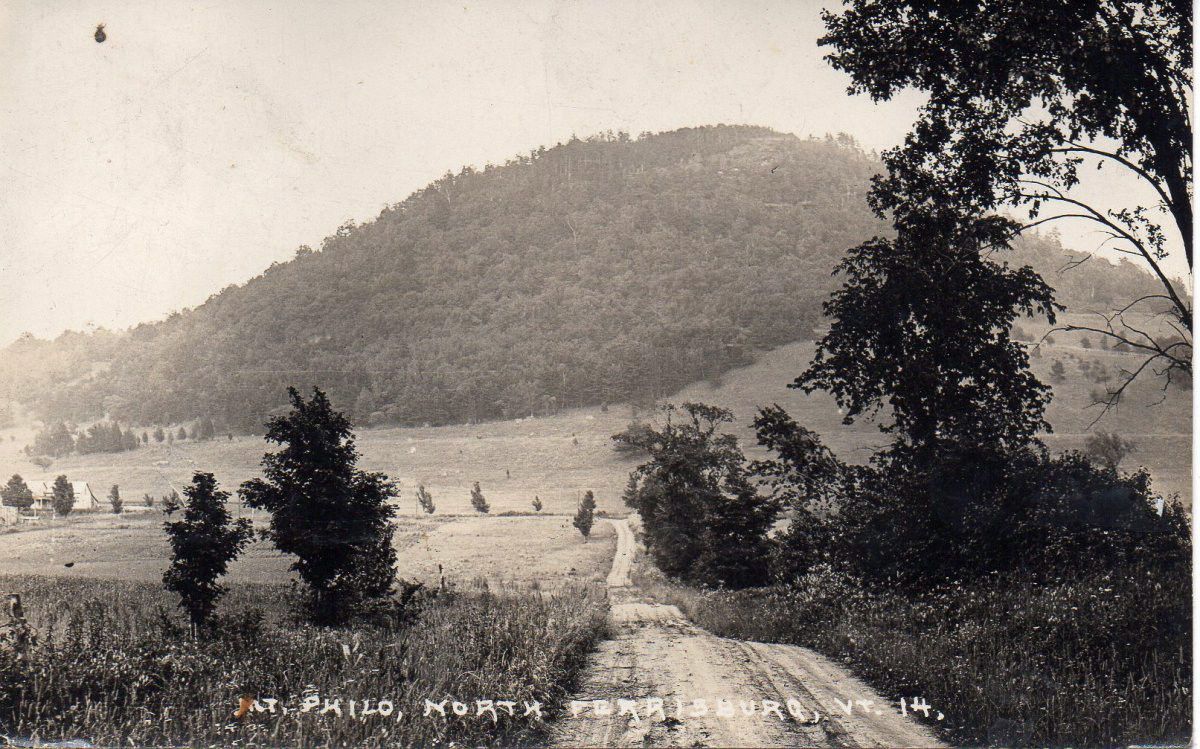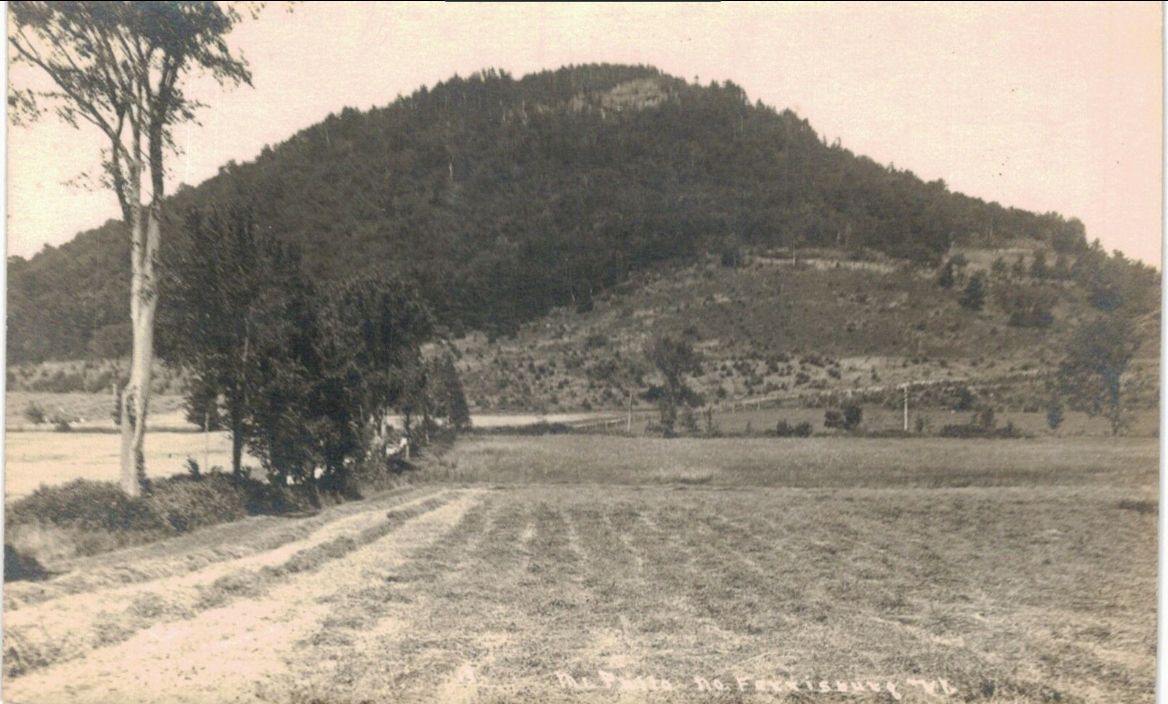Early history starting 1896
The Mt. Philo Inn was built in 1896 by Frank Lewis who had crafted a small house nearby. The Lewis family owned about 400 acres, including all of Mt. Philo. Lewis was persuaded to build the inn by travelers who used Lake Champlain as a travel route and needed a place to stay. Guests would disembark at Thompson's Point, a couple miles away. In 1924 the Lewis and Humphrey's family donated Mt. Philo to the state of Vermont to create Vermont's first and most popular state park.
1964
Until 1966, the Mt. Philo Inn was maintained as a well-known and much-loved vacation resort by generations of the Lewis/Wells family. The inn included a full-service restaurant and a staff of 25 that attended to the guests. Accommodations were eclectic: glamping (luxury camping) tents, cabins and 16 rooms at the inn. The rapid spread of inexpensive chain motels in the 1960s reduced business at the inn, forcing the Lewis/Wells family to sell.
In 1970 the Inn was purchased by a collective, a group of individuals living together with a common purpose and shared decision making. This thriving community attracted intellectuals and future politicians, including Bernie Sanders.
The Mt. Philo Inn commune was established in 1970 and lasted until 1975. During that time this group of activists were instrumental in forming People's Free Clinic, now known as Community Health Center in Burlington, the burlington Co-op, now City Market, and The Schoolhouse, an alternative school.
A documentary (here) by the Vermont Historical Society and Vermont PBS Examines the influx of back-to-the-landers, peace activists, and disenfranchised youth who flocked to Vermont in the 1970s in search of a different way to live. In the process, they precipitated progressive social and political change in the state that impacts Vermont to this day.
A verbal history of the commune was recorded by member Bridget Downy-Meyer. Here She speaks of dropping out of UVM, becoming a single mother, working with draft resisters. She describes communal living at the Inn, and of transitioning into a collective, the decision-making process and the difficulty of arriving at consensus. She talks of founding of the People's Free Clinic, (now Community Health Center working with a mostly immigrant population), The Schoolhouse, an alternative school in Shelburne. and the relationship of Mount Philo to other communes. Topics include taking in the Earthworks commune children after a fire, open relationships, nudity, and child rearing. She ends the interview by describing the effect of the counterculture on Vermont.
The Living Theatre
The world-renowned performance group-- The Living Theatre, resided at the Mt. Philo Inn for nine months in 1974. Julian Beck and Judith Molina rose to fame in the world of international avant-garde theatre by producing a series of controversial theatrical works that attempted to marry politics and expression, trying to eliminate the distinction between life and art. Al Pacino said “The audience became the theater. They were the event. They were the play. And on one side of the theater was Judith Malina and on the other side was Julian Beck. They were controlling it on either side. They were orchestrating it. And it was literally the most exciting, vibrant alive thing that I - I can only describe it as changing my life. At the Mt. Philo Inn they created the political production "The Money Tower."
Mt. Philo
In 2018 Chaves began writing a book based on her findings. Secrets of Mount Philo: A Guide to the History of Vermont's First State Park, recently published by the Vermont Historical Society, is a fascinating trip through the mountain's intricate past and a guide to its relics, hidden byways and natural communities.
Chaves dedicated the book to her grandson, Asa, "and his generation, the future stewards of our public lands."
Mount Philo emerged millions of years ago in the mists of geologic time. Scientists call it a klippe, a relic of the Champlain Valley thrust fault. Such a fault appears when one immense plate of the Earth's crust is forced up over another. The formation of the Champlain Valley thrust fault, which occurred roughly 500 million years ago, is one of the mega-events that shaped the Champlain Valley. Philo, like Snake Mountain off to the southwest and other rocky eminences rising above the valley, is an eroded remnant of the leading edge of that thrust.
click to enlarge
COURTESY OF JUDY CHAVES
Postcard of original wood tower on Mount Philo
Ever since humans came along, hundreds of millions of years later, Philo's summit has provided visitors with an unparalleled vista of the Champlain Valley, Lake Champlain and the Adirondack Mountains across the lake in New York. There's no evidence that Native Americans lived on the mountain, but they may have used it as a strategic lookout.
Nobody knows for sure how Mount Philo got its name. The most likely explanation, Chaves believes, can be found in Esther Munroe Swift's classic book Vermont Place Names: Footprints of History, which says it was probably named during one of New England's "bursts of enthusiasm for names with a classical flavor." Philo means "love" in Greek.
As European settlers moved into Vermont, farms began to surround Mount Philo. And as the nation's demand for wool grew, nearby sheep farming burgeoned. By the middle of the 19th century, the mountain was completely denuded of its primeval forest cover.
That was the story throughout Vermont. In the 1840s, Chaves' book and other historical references point out, nearly 1.7 million sheep inhabited the state, and farmers had cleared three-fourths of its trees. But after the Civil War, the demand for wool declined, the Midwest opened — with its flat, fertile, more temperate lands that could produce meat and wool more efficiently — and sheep farming moved west.
Dairy cows took the place of sheep and soon dominated Vermont agriculture. Since cows don't climb mountains, the lower slopes of Mount Philo remained pasture, but forests returned to its rocky upper half.
Then, as now, making money from a farm was difficult, and many Vermont farmers began taking in city tourists to supplement their income. It was, in effect, an early form of agritourism. In 1886, Frank and Clara Lewis bought a farm about a quarter mile south of Mount Philo and started welcoming tourists from New York City and Boston. Their business prospered, and they replaced the original farmhouse with a larger, more comfortable building they named Mount Philo Inn.
At that point, fate stepped in. A wealthy Massachusetts couple, James and Frances Humphreys, came to stay at the inn, fell in love with the place and began summering there. They regularly trekked up the adjacent mountain.
At about the same time, carriage roads were becoming fashionable on mountains throughout the Northeast, giving visitors an elegant and less sweaty alternative to hiking uphill. In 1901, Frank Lewis began constructing a carriage road on Philo. Along the roadway he built gazebos, rest stops, a springhouse and other amenities. Eventually, Lewis built a 50-foot wooden tower on the summit that offered a 360-degree view. (Later, steel towers replaced the wooden one. None remain today.)
As Chaves points out in her book, similar construction was going on all over the region. Carriage roads wound their way up Snake Mountain, Camel's Hump, Mount Mansfield, Mount Equinox and the White Mountains of New Hampshire. If you had a mountain — even a small one — you wanted a carriage road on it so your guests could navigate it in style.
By 1902, Mount Philo was a fully equipped tourist attraction, and Lewis promoted it in exuberant prose. A pamphlet declared: "The mountain road, threading its way through open fields and woods, affords a variety and intensity of scenic beauty seldom equaled in New England."
James and Frances Humphreys were his most enthusiastic guests. The couple bought land for a summer home near the mountain and eventually came to own the peak itself. Even after James died, in 1914, Frances continued to come to Vermont and was deeply devoted to Mount Philo. She wrote touching, sentimental verse about it.
When someone asked Frances whether she would have the mountain timbered, she insisted she would not cut a single stick. "There is something in the world besides money," she said.
Photo taken from the beginning of the original Carriage Road to Mt. Philo. At the bottom of the photo are short young black willow trees. Moving up you can make out a cluster of young sugar maple trees. In the center of the photo is the now ancient sugar maple. All these trees are now fully mature.
The Inn
Our collection of old photos.


